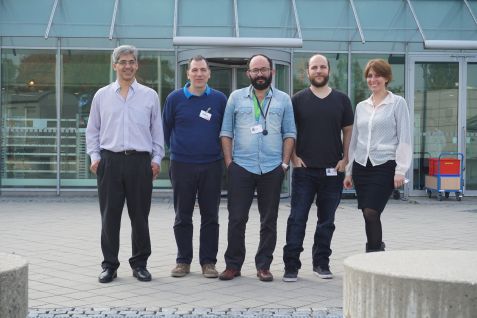MLZ is a cooperation between:
 > Technische Universität München
> Technische Universität München > Helmholtz-Zentrum Hereon
> Helmholtz-Zentrum Hereon
 > Forschungszentrum Jülich
> Forschungszentrum Jülich
MLZ is a member of:
 > LENS
> LENS > ERF-AISBL
> ERF-AISBL
MLZ on social media:

MLZ (eng)
Lichtenbergstr.1
85748 Garching
14.11.2017
Hochrangiger Besuch aus Argentinien

The inquisitive visitors from Buenos Aires (from left to right: Javier Santisteban, Miguel Vicente Alvarez, Gabriel Juarez, Manuel Suarez, and Karina Pierpauli. (Photo: FRM II / TUM) © FRM II / TUM
The National Atomic Energy Commission (CNEA), Argentina is currently building a new 30MW multi-functional reactor in Buenos Aires, scheduled to go into operation at the beginning of the next decade. The need for radioisotopes is also growing in Argentina, so their production is a major purpose of the new neutron source.
Above all, the new reactor should deliver a high neutron flux in order to satisfy both the needs of scientists and industry. The focus is on neutron scattering with cold and thermal neutrons, the so-called LAHN project (Laboratorio Argentino de Haces de Neutrones). Its Scientific Director, Dr. Javier Santisteban, and the Director of Administration, Karina Pierpauli, therefore embarked on an extended trip to Europe in September on all the major neutron sources. At FRM II they were to discuss cooperation opportunities.
This new reactor will be equipped with an imaging beamline (ASTOR) and a diffractometer (ANDES) for material science experiments. The Argentines therefore have approached Dr. Burkhard Schillinger and Dr. Michael Hofmann from the FRM II to advise the Instrumentation Committee on the design of these devices. An initial evaluation round took place in mid-March 2017 in Buenos Aires. But it’s not just about conversation: Aureliano Tartaglione, the future instrument manager for ASTOR, spent one year with Dr. Burkhard Schillinger working at the instrument ANTARES. Since 1st of September, two more young scientists from Argentina, Dr. Manuel Suarez and Gabriel Juarez, are here on site for a training of nine months. Manuel Suarez will lead the Sample Environment for LAHN in the future and is sitting in on Jürgen Peters’ group. Gabriel Juarez is the future instrument scientist for ANDES and therefore works closely with Dr. Michael Hofmann.
Dr. Javier Santisteban and Dr. Michael Hofmann also work together on a project on texture and residual stresses in extruded tubes made of zirconium alloy. For this, they have travel funds available for 2017 and 2018 via third-party funding (CONICET / BAYLAT). When the conversation about the planned cooperation took place in September, Dr. Javier Santisteban and Dr. Miguel Vincente-Alvares (instrument manager ANDES) took a measurement at the FRM II and therefore were already on site. The scientists on both sides of the Atlantic have been working together well for some time now.
MLZ is a cooperation between:
 > Technische Universität München
> Technische Universität München > Helmholtz-Zentrum Hereon
> Helmholtz-Zentrum Hereon
 > Forschungszentrum Jülich
> Forschungszentrum Jülich
MLZ is a member of:
 > LENS
> LENS > ERF-AISBL
> ERF-AISBL
MLZ on social media:


